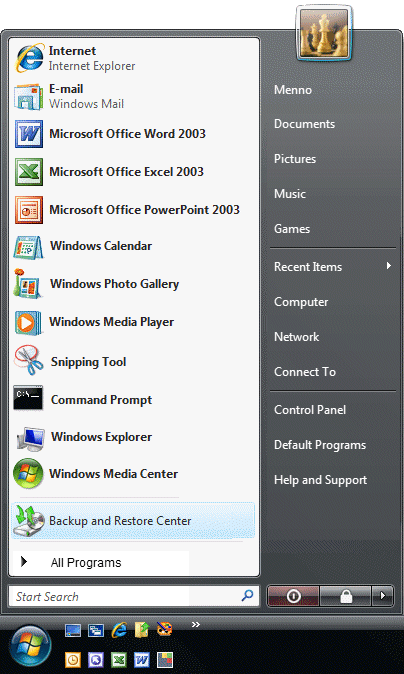
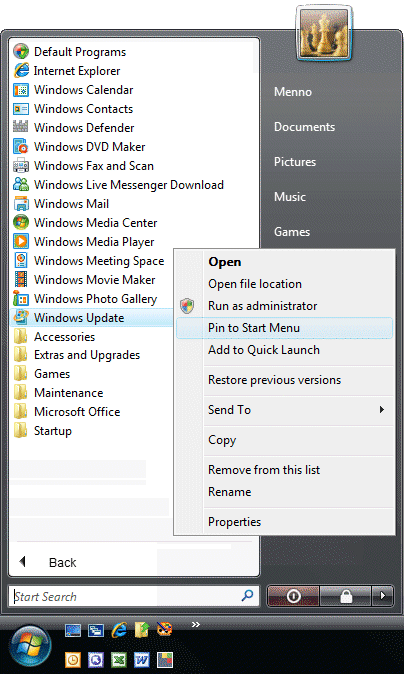
This page describes the settings concerning the Windows Vista user interface like the Start menu, Taskbar, Quick Launch, Sidebar and the Desktop to improve the user experience.
The Start menu of Windows Vista has been improved in comparison to it's predecessor in Windows XP. Unfortunately, opening the programs still takes a few clicks because they are stored in the menu All programs. By right clicking a program and selecting Pin to Start menu (like shown below), a program can be added to the short (but quickly available) list of programs in the Start Menu. Besides the programs pinned to the Start menu, there are also programs (below the horizontal line) which have been used recently.


Default Programs vs. All Programs
Every newly installed program ads a folder and shortcuts to the menu All Programs (unless this option has been disabled at setup), which makes the program easy to find. This list can be a mess, especially when a lot of software has been installed therefore a more logical structure (like pinning a program to the Quick Launch menu or adding a toolbar to the taskbar as described below) would improve the overview.
|
|
USING START SEARCH TO FIND AND START A PROGRAMPrograms which aren't pinned to the Start menu (or placed elsewhere within easy reach), can be started easily by typing the first letters of the program in the search field of the Start menu Start Search. The search results are shown in the Start menu. |
Changing the lay-out of the Start menu
The lay-out of the Start menu can be changed by right clicking an empty area of
the Start menu and selecting Properties. To show or hide the shortcuts on the right side of the
Start menu, select the button Customize on the tab Start
menu.
If preferred, hide the shortcuts to
Connect To,
Default Programs,
Help, Network and Search
and/or add the shortcut to Favorites menu. By disabling the alphabetic ordering,
the shortcuts to folders and programs can be ordered as desired (option
Sort All Programs menu by name).
After disabling this option, the order can be changed by dragging and dropping
the shortcuts. In case
the Start menu is to small to show all programs, the size of the shortcut icons can be adjusted in size by
disabling the option Use large icons. Disable the option Highlight newly installed
programs if it the yellow highlighted
background of the newly
installed programs in the folder All
Programs of the Start menu is not desired.
Minimize the number of shortcuts to programs in the folder Startup
The programs with
a shortcut in the folder Startup (in the subfolder All Programs of
the Start menu) will start automatically with Windows. Make sure the programs
which are not used (any more) are removed from this folder. By default, some programs
place a shortcut in this folder to a small executable which prepares a quick
start of the program or start other programs. These startups occupy rare system resources,
remove them (by
drag-and-drop) when there is no added value!
CHANGING THE START MENU USING THE WINDOWS EXPLORERThe shortcuts in the folder All Programs are stored on two different locations: one folder with shortcuts to programs for all users (C:\ProgramData\Microsoft\Windows\Start Menu) and one folder with shortcuts to programs for each individual user (C:\Users\loginname\AppData\Roaming\Microsoft\Windows\Start Menu). Use the Windows Explorer to browse these folders and add or remove shortcuts and subfolders. |
Changing the default e-mail program
or browser
In Windows Vista,
Windows Mail is the default
e-mail program.
By default a shortcut to Windows Mail and Internet Explorer are pinned to the Start menu, these
setting can be changed
by right clicking the taskbar,
Properties, tab
Start Menu,
button Customize.
Check the
settings in Default Programs
in the Control Panel,
task
Set your default programs as well.
This area makes it possible to set the default programs for internet, e-mail,
calendar, contacts, pictures
and media.
Changing the default folder to open the Windows Explorer
The button Computer (part
of the Start menu) opens the Windows Explorer, by default in the 'folder'
Computer. Although this
location can be of use, it is not always the most practical folder to start
with. To change the folder which is opened by default, right click the prefered
folder in the Windows Explorer and select Send to,
Desktop (create shortcut).
Open the Properties of this shortcut (right click the shortcut) and
change the command for the variable Target. The command "%SystemRoot%\explorer.exe /n, /e, D:\"
for example will open the Windows Explorer in the root of the partition with the
letter D: (tip: select Maximized
for the variable
Run to open the Windows
Explorer using the full screen by default). After the name of the shortcut has
been changed, move the shortcut to the Start menu by drag-and-drop.
The behavior of the Taskbar can be changed by right clicking an empty area of the Taskbar follow by Properties. In Windows Vista it is better not to use the option to hide the Taskbar (Auto-hide the taskbar) because Windows Vista shows some of the administrator messages on the Taskbar. If these messages waiting for confirmation are not vissible by the user, it is not clear why there is nothing happening. A double height of the Taskbar (by dragging the top of the Taskbar upwards) creates more space for the Quick Launch menu and the active programs. This change creates more space to show both the time and date. To be able to drag the top upwards, the Taskbar must unlocked by right clicking it and deselecting Lock the Taskbar.
START MENU AND TASKBARStart the Group Policy Object Editor with the command GPEDIT.MSC for more possibilities to change the Start menu and the Taskbar. Select the option User Configuration, Administrative Templates, Start Menu and Taskbar to change the options for Remove Balloon Tips on Start Menu items and Turn off all balloon notifications. Browse through the other options in User Configuration for more option which are not available through the normal user interface. |
If there are already many programs pinned to the Start menu, there is probably not much space left to add more. The area All Programs will soon become a mess as well because of the number of installed programs. Fortunately, there is another way of to get a quick and clear access to programs: the Quick Launch menu, places at the right of the Windows Start button. By default, most program installation routines place a shortcut in this area, which can be rearranged (by drag-and-drop) and/or completed with self chosen shortcuts or folders. Depending on the available size, new shortcuts are placed under the >>-sign (see the picture). If the Quick Launch menu is not visible at all, activate it by right clicking the Taskbar and select Toolbars, Quick Launch.
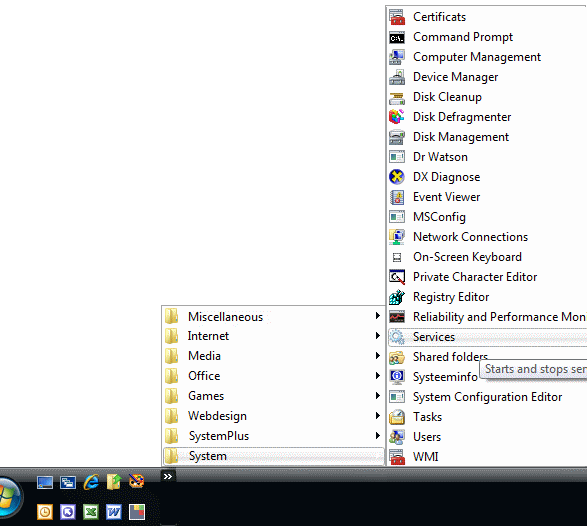
The shown shortcuts in the Quick Launch menu are also available without the use of a mouse by pressing the Windows key in combination with one of the numeric keys. In the above example, the Windows key in combination with the key 3 will open the Internet Explorer (because the IE-icon is the third icon of the Quick Launch menu on the Taskbar). For this functionality it is probably wise to double the height of the Taskbar, in which case the maximum of 10 shortcuts can be shown efficiently. The used space for the Quick Launch area can be enlarged (at the cost of the remaining space of the Taskbar). For both changes, the Taskbar must be unlocked first.
Show desktop, Flip 3D and
browsing through the running programs
The Quick Launch menu has a few default shortcuts. The first shortcut minimizes
all open programs to the Taskbar to show the desktop, this is useful if a lot
of shortcuts have been placed on the desktop. The second shortcut
opens a 3D environment (known by Flip 3D, a useful alternative to the
key combination ALT-TAB) which makes it possible to scroll with the mouse
through the running programs and to open one of them quickly (this functionality
is only useful in case there are a lot of running programs). This shortcut can
also be activated with the Windows key
(possibly in combination with the CTRL key) in combination with pressing
a few times the TAB key. In this case, the mouse will scroll through the
running programs as well (hold the Windows key).
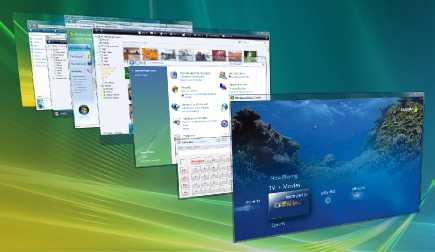
Changing the appearance of the Quick Launch menu
It is quit easy to extend the Quick Launch menu by drag shortcuts to the Quick
Launch area and to drop at the moment of the appearance of a vertical line.
Adding shortcuts is also possible by right clicking a program or shortcut and to
select Add to Quick Launch.
Clicking the >>-sign shows the other 'hidden' shortcuts in the
Quick Launch menu. In the example above, the Quick Launch menu has been extended
with additional folders (with additional shortcuts to all available programs)
which immediately create a better overview compared to the Start menu.
Removing shortcuts from the Quick Launch is easy: right click the shortcut to be
deleted and select Delete.
The folders in the shown Quick Launch menu have been added manually within the
Windows Explorer at the following location:
C:\Users\loginname\AppData\Roaming\Microsoft\Internet Explorer\Quick Launch
Click right on an empty space in the Windows Explorer just below the current folders and select New, Folder. Adding shortcuts to these folders is done by copying shortcuts (like the shortcuts in the above mentioned folder for All Programs of the Start menu).
Adding additional toolbars
The Taskbar can be extended with additional shortcuts to existing folders
which makes it possible to gain quick access to frequently used files. By right
clicking the Taskbar, choosing for Toolbars, New toolbar..., and
selecting a folder (like the folder Documents) it becomes easy to create a quick menu to this folder.
These additional toolbars are placed at the left, next to the system tray, the
files in these quick links are available by pressing the >>-sign. In the
example below, the folder SchoonePC has been added which makes the
files and folders in this folder quickly accessible.

REMOVING THE LANGUAGE BARThee Language bar (at the left of the system tray, see the example above) can be of use to add a second language or keyboard layout. In most cases however, there is no need for this support in which case it is better to deactivate the Language bar by right clicking the taskbar, option Toolbars. Experience will learn whether it will come back automatically or not, in which case the Language bar can be deactivated as well by right clicking the Language bar and to select Settings, tab Language bar and to activate the option Hidden. This setting is also available by the Control Panel, Regional and Language Options, tab Keyboards and Languages, button Change keyboards, tab Language Bar. If this option enables automatically in time as well, remove the unused installed services on the tab General. Removing the unused input languages prevents the irritating and unintended keyboard layout change as well (which occurs after pressing the key combination left ALT-key and right SHIFT-key). |
Normally the System tray/Notification Area (at the right side of the Taskbar) is filled with lots of icons of active programs running in the background. The icons are a shortcut to open the program, but most of them are not used at all. By hiding the less important icons, the overview of the system tray becomes clearer. Hiding of icons is done by right clicking the clock or an unused area of the system tray and chose for Properties, tab Notification Area, button Customize. In this window select the icons which need to be hidden behind the arrow on the Taskbar by default. On this tab one can hide the volume icon, the clock, the network connections and the remaining power level for laptops.
Show the date in the system tray
By default, a clock is shown in the system tray. By doubling the height of the
taskbar, the day of the week and the date are shown as well. Clicking the
date/time followed by Change date en time settings opens the windows Date and
Time where on the tab Additional Clocks two additional time zone clocks can be activated.

Windows Vista introduces a new tool on the desktop: the Sidebar, a vertical column which can be filled with al kinds of gadgets. Windows Vista supports by default a few gadgets for immediate use (like different clocks, a calendar, contacts, a miniature slide show of personal pictures, stock prices, notes, RSS-feed headlines and weather forecasts). Right click the sidebar and select Add Gadgets to add new gadgets, the option Get more gadgets online (bottom right) has much more useful gadgets available, ordered by Top downloads and Top rated (this overview of gadgets is renewed frequently).
Unfortunately, there is not a lot of space available on the sidebar, but gadgets can also be dragged to the desktop, in which case they are still available (and sometimes even bigger in size like the slideshow). If the sidebar is used a lot, it is probably wise to show the Sidebar always on top of other programs, to do this click right on the sidebar, select Properties and activate the option Sidebar is always on top of other windows. After this option is activated, programs can only be maximized to the still remaining space on the desktop (the gadgets moved to the desktop stay in the background). Users of a wide screen probably won't bother the used space, this option is however not suitable for users of lower resolution monitors. If multiple monitors are used, the Sidebar Properties make it possible to move the Sidebar to the other monitor.
TIP: The gadgets on the sidebar can use a lot of system resources. If this is significantly and annoying, then it is better to disable the sidebar at startup. This can be done by the Properties of the sidebar by disabling the option Start Sidebar when Windows starts.
To keep a good overview, limit the number of shortcuts (like the recycle bin, frequently used programs and folders) placed on the desktop. A well designed Start menu and Quick Launch menu makes it unnecessary to place many shortcuts on the desktop as well. Be aware that it is not wise to place any personal files on the desktop; it enlarges the risk of losing data! Personal files belong in the folder Documents (which can be within quick reach by placing a toolbar on the taskbar, see information above). If you would like to have quick access to personal files on the desktop, place shortcuts to the files and/or folders by right clicking it and choosing for Send To -> Desktop (create shortcut).
TIP: The item Personalization in the Control Panel (also available by right clicking the desktop), option Change desktop icons (at the left in the task pane) makes it possible to hide and show default shortcuts (like the recycle bin). The desktop background picture can be changed to one of the personal image at Desktop Background, button Browse (browse to the folder with personal images and select the desired background image).
AUTOMATICALLY CHANGING THE DESKTOP PICTUREBoring, every day the same desktop picture? Tools like John's Background Switcher (download: www.johnsadventures.com/software/backgroundswitcher/) continuously change the desktop picture after a certain amount of time. This tool supports multiple monitors! Visit the page about automatically changing the desktop picture for more information. |
SAVE AND RESTORE DESKTOP ICON POSITIONSAre you a heavy user of desktop icons, and get irritated when your icons get messed up? Probably the tool IconRestorer (download: http://fsl.sytes.net/iconrestorer.html) is something for you! With IconRestorer you can backup the icon locations and, when needed, restore them easily to the location at the time of the backup.
|
The monitor is the most important hardware for the interaction between the user and the computer, a good reason to optimize the monitor resolution and other display settings. Right click the desktop and select Personalize to change the different settings concerning the screen. First set the correct monitor resolution and highest possible color depth, fortunately in most cases Windows Vista does this by default.
Change the resolution to the most optimal resolution for the monitor. In most cases this is 1024*768 pixels for a 17 inch or smaller screen, for the larger screens try the resolution 1280*1024 pixels (or even 1600*1200 pixels). Use one of the widescreen resolutions in case of a widescreen monitor (see the technical specifications in the manual). Check the screen refresh rate as well (button Advanced settings, tab Monitor), which in most cases can be set to 75 Hertz to realize a more stable screen.
TIP: The flat screens have all their own optimal resolution because of the available pixels, a deviating resolution will result in a bad display quality because of the interpolation or extrapolation of pixels.
ADVANCED CHANGES TO THE GRAPHICS HARDWAREIf you really want the most out of your monitor en graphics hardware, you have to try the application PowerStrip from EnTech Taiwan (download: www.entechtaiwan.com/util/ps.shtm). With PowerStrip you can make changes to the settings of your graphics hardware and monitor. Your are warned: it's at your own risk, it is possible to make permanent damage! Be careful: read the manual first. By the way: PowerStrip supports almost all graphics cards, check the website if your graphical hardware is supported. If needed, the tool GPU-Z (download: www.techpowerup.com/gpuz/) can be used to find out the technical details of the graphics card. |
Enlarging the text and cursor
If the text on the screen has become too small and hard to read, then
resizing the letters is an option. This can be done with the option Adjust
font size (DPI) in the
task pane of the
Personalization window,
button Custom DPI.
Enlarging to 110 or 115% is in most cases a big improvement for
most users.
If the horizontal cursor in the text editor is also difficult to see, double or
triple its height at the Control Panel,
option Ease of Access Center, Make the computer easier to see, Make the focus
rectangle thicker.
Nowadays, it is common to work with a big screen (19 inch or more) and/or multiple monitors. Within Windows, it's easier to work with two monitors compared to a single big screen because two screens make it easy to maximize a running program easily to the active screen (half the desktop instead of the whole desktop in case of the situation with one screen). Dragging running programs (if not maximized) to the other monitor is easy as well. The individual position of the monitors can be set at Personalization in the Control Panel, option Display Settings.
Extending the taskbar to multiple monitors
Unfortunately, within Windows it is not possible to extend the taskbar or add
another taskbar on the second or third monitor. The tool MultiMon taskbar (download:
www.mediachance.com) makes it possible to extend the
taskbar to the second monitor. The taskbar icon will only be shown on the
taskbar of the screen where the window is active. Every window will have a new
option to move the window quickly to the other monitor, even if it's maximized.
Besides these extra options, the taskbar has the possibility to extend the
clipboard as well. The only negative point is the old fashion look.
Stretching the desktop background
picture over multiple monitors
The use of multiple desktop background
pictures is not supported as well. Fortunately it is possible to create a
stretched background image (where the different images are placed next to
each other with image editing software) yourself. The size in pixels of the new
image should be equal to the resolution of the used monitors. For example: for a
setup with two monitors with a resolution of 1024*768 pixels needs a desktop
background image with the size 2048*768
pixels. Resize the images to the monitor resolution first (in this example a
resolution of 1024*768 pixels for each picture), place them next to each other
into a single image (in this example an image with a resolution of 2048*768 pixels).
The next step is to change the desktop background image the normal way by right
clicking the desktop and browse to the new image after selecting Personalization, option
Desktop Background. Select the middle option (Tile) at the question
How should the picture be positioned?
at the bottom.

TIP: Unfortunately, there are no options to set a different background for each monitor. This can be solved with a tool like John's Background Switcher.
If the graphical card is suitable for the rendering of complicated 3D, Windows Vista will startup automatically with the more advanced Aero Glass-interface which supports transparency. The new interface needs a graphical card with a special graphical processor (GPU) with support for the new Windows Device Driver Model (WDDM). This is the case when the graphical card supports DirectX 9. If it is not possible to show the Aero Glass-interface, Windows Vista will automatically return to a less demanding view. The Aero Glass-interface settings can be changed at the Control Panel, item Personalization, option Window Color and Appearance (a change in these settings will result in an immediate change of the current window).
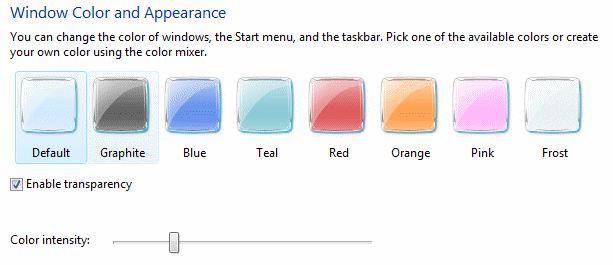
If there is a delay in opening, minimizing, maximizing, dragging and closing windows, disable visual settings to achieve less graphically demanding settings. Disabling the transparency (see the picture) has the most effect, especially in case of older graphical cards or in case the graphical calculations are done by the CPU (in case there is no graphical card). There are more options available by the link Open classic appearance properties for more color options at the bottom of the window Window Color and Appearance where the Aero-interface can be changed to the Windows Vista Basic Color scheme (or even the Windows Classic scheme). The example below shows the difference between the Aero Glass-interface (at the right) and the Basic-interface (at the left with the additional button of MultiMon which is not visible with the Aero Glass-interface).

The button Effects (in the same window) makes it possible to disable more visual effects, to gain some improvement (especially disabling the option Show window contents while dragging can result in some system performance). Keep the option ClearType enabled because it results in better readable screen letters.
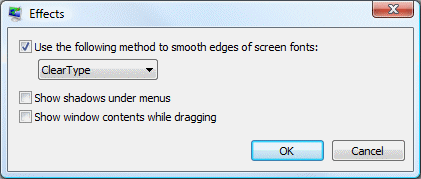
The advanced system settings offer more possibilities to change the visual effects. Go to the Control Panel, item System, task Advanced system settings (at the left in the task pane), tab Advanced, button Settings (as part of Performance). Optimal system settings (while keeping the most important visual effects) are achieved after disabling all options (with the option Adjust for best performance, as shown below) with the exception of Enable desktop composition, Enable transparent glass (if desired), Show thumbnails instead of icons (shows the small images), Use drop shadows for icon labels on the desktop (transparency of the desktop icon labels), Use visual styles on windows and buttons and Smooth edges of screen fonts (also known as ClearType).
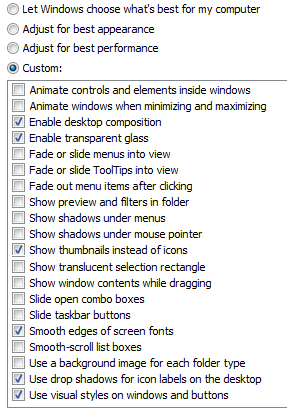
© 2001-2022 - Menno Schoone - SchoonePC - Rotterdam - The Netherlands